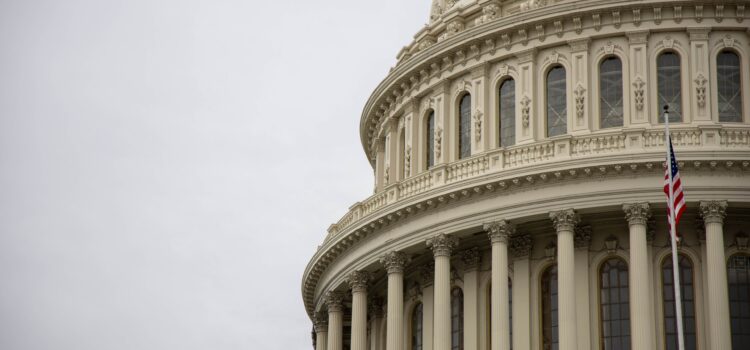

This article is an excerpt from the Shortform book guide to "Alexander Hamilton" by Ron Chernow. Shortform has the world's best summaries and analyses of books you should be reading.
Like this article? Sign up for a free trial here.
What was the first party system in the US like? What did each party advocate for?
According to Alexander Hamilton by Ron Chernow, the politician of the same name played an important role in the forming of the first American political parties. These parties are known as the Federalist and Republican parties.
Discover more about the first party system and their beliefs.
Federalism Versus Republicanism
While serving as Treasury Secretary, Hamilton became an important figure in the emergence of the first party system, which had begun to develop during the Constitutional ratification process and became powerful forces under the Washington administration. They were not formal organizations, but loose alliances of politicians who shared beliefs about the US economy, foreign relations, the future of slavery, and so on. Loyalty tended to consolidate around powerful figures, and Chernow argues that Hamilton and Jefferson were the unofficial heads of the Federalist and Republican parties, respectively. Both men dominated American politics even after they each left their positions in Washington’s cabinet.
(Shortform note: The terms “federalist” and “republican” accurately describe the US government, since it is both a federation (a union of states under a central government) and a republic (a democracy in which citizens elect officials to represent them). The Federalists of the 1790s took their name from the pro-Constitution faction of the ratification process (the anti-Constitution faction were the “anti-federalists”), while the Republicans took their name from the French revolutionaries who overthrew France’s monarchy in 1789. These names reflect the parties’ different visions for how the US should function: by consolidating many perspectives into a single authoritative voice, or giving those many perspectives an equal voice in debate.)
The development of political parties was initially viewed with alarm by many, as they were seen as a threat to cooperation in government and a vestige of the monarchy, in which factions competed for the king or queen’s favor. As a result, party activity such as selecting presidential candidates to represent the larger group’s interests was generally done behind the scenes. In his 1796 farewell address, Washington disavowed “factionalism” and asked that politicians seek unity over infighting, to little effect. The press recognized and wrote about party allegiances, and several pro-Federalist and pro-Republican newspapers were funded by Hamilton and Jefferson to drum up public support for their causes.
(Shortform note: The US has consistently had two dominant political parties throughout its history, though the modern-day Democratic and Republican parties didn’t emerge until the mid-1800s, and their political stances have shifted dramatically over nearly two centuries. While there are other parties, such as the Libertarian and Green parties, political analysts generally agree that the structure of US elections makes it next to impossible for them to gain influence.)
North Versus South and the Slavery Question
Chernow notes that most Federalists came from northern states, while most Republicans came from southern states. This was reflected in the parties’ contrasting beliefs about the future of the US economy. The North was increasingly urban and dependent on manufacturing, and while slavery was still practiced in states like New York and New Jersey, slaves were a small portion of the population and mostly worked in domestic household positions. By contrast, in southern states like Virginia and South Carolina, the economy depended on the production of cash crops like sugar, cotton, and tobacco on massive slave plantations, and slaves made up close to half of the total population.
Chernow describes Hamilton as a committed abolitionist who worked with the New York Manumission Society to defend slaves and free African-Americans in court. While not all Federalists opposed slavery outright, many favored scaling back the practice alongside a push toward greater industrialization to create a domestic market for American raw materials. Republicans, on the other hand, largely saw slavery as essential to the American way of life and condemned the push for abolition as an attempt by Federalists to break down Republican power and deprive southern voters of economic influence. Several fights against slavery were waged in Congress in the last years of the 18th century, but all failed.
Friendship With Britain Versus With France
France’s democratic revolution in 1789 and subsequent war with much of Europe, including Britain, would become a flashpoint in the struggle between Federalists and Republicans. The two parties disagreed about whether to maintain neutrality in the conflict and which country—Britain or France—could prove to be a better ally to the US in the coming decades. Though both Jefferson and Hamilton had left office by 1794, they continued to exert influence in Congress and the cabinet of the US’s second president, the Federalist John Adams.
The Federalists favored a renewed friendship with Britain, seeing it as a more stable and economically valuable partner. Hamilton in particular advocated for increased trade between the US and Britain. By contrast, Republicans saw the French Revolution as the ideological companion to the American Revolution, fought against a monarchy on the same principles of democracy and freedom. Jefferson and others also argued that the US owed France for its assistance during the Revolutionary War.
The Slow Collapse of Federalism
By the end of the 18th century, Federalism’s popularity was waning. Chernow argues that the party lost all significance under a succession of Republican presidents, beginning with Jefferson’s election in 1800. Though Federalism continued operating for another decade, it had few voters outside of New England. Chernow attributes the party’s collapse to infighting, a series of unpopular measures implemented by Adams, and Hamilton’s own diminishing influence as he was beset by scandal and increasingly out of step with the party line.

———End of Preview———
Like what you just read? Read the rest of the world's best book summary and analysis of Ron Chernow's "Alexander Hamilton" at Shortform.
Here's what you'll find in our full Alexander Hamilton summary:
- The biography of Alexander Hamilton that was adapted into the Broadway musical
- The life and influence of the overlooked Founding Father
- How Hamilton's life ended in scandal and a fatal duel






